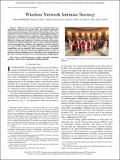| dc.contributor.author | Rabbachin, Alberto | |
| dc.contributor.author | Conti, Andrea | |
| dc.contributor.author | Win, Moe Z. | |
| dc.date.accessioned | 2015-06-08T15:29:14Z | |
| dc.date.available | 2015-06-08T15:29:14Z | |
| dc.date.issued | 2015-02 | |
| dc.date.submitted | 2013-07 | |
| dc.identifier.issn | 1063-6692 | |
| dc.identifier.issn | 1558-2566 | |
| dc.identifier.uri | http://hdl.handle.net/1721.1/97215 | |
| dc.description.abstract | Wireless secrecy is essential for communication confidentiality, health privacy, public safety, information superiority, and economic advantage in the modern information society. Contemporary security systems are based on cryptographic primitives and can be complemented by techniques that exploit the intrinsic properties of a wireless environment. This paper develops a foundation for design and analysis of wireless networks with secrecy provided by intrinsic properties such as node spatial distribution, wireless propagation medium, and aggregate network interference. We further propose strategies that mitigate eavesdropping capabilities, and we quantify their benefits in terms of network secrecy metrics. This research provides insights into the essence of wireless network intrinsic secrecy and offers a new perspective on the role of network interference in communication confidentiality. | en_US |
| dc.description.sponsorship | Marie Curie International Fellowship (Grant 2010-272923) | en_US |
| dc.description.sponsorship | Seventh Framework Programme (European Commission) (Project CONCERTO Grant 288502) | en_US |
| dc.description.sponsorship | Copernicus Fellowship | en_US |
| dc.description.sponsorship | National Science Foundation (U.S.) (Grant CCF-1116501) | en_US |
| dc.description.sponsorship | United States. Office of Naval Research (Grant N00014-11-1-0397) | en_US |
| dc.description.sponsorship | Massachusetts Institute of Technology. Institute for Soldier Nanotechnologies | en_US |
| dc.language.iso | en_US | |
| dc.publisher | Institute of Electrical and Electronics Engineers (IEEE) | en_US |
| dc.relation.isversionof | http://dx.doi.org/10.1109/TNET.2013.2297339 | en_US |
| dc.rights | Creative Commons Attribution-Noncommercial-Share Alike | en_US |
| dc.rights.uri | http://creativecommons.org/licenses/by-nc-sa/4.0/ | en_US |
| dc.source | Other repository | en_US |
| dc.title | Wireless Network Intrinsic Secrecy | en_US |
| dc.type | Article | en_US |
| dc.identifier.citation | Rabbachin, Alberto, Andrea Conti, and Moe Z. Win. “Wireless Network Intrinsic Secrecy.” IEEE/ACM Transactions on Networking 23, no. 1 (February 2015): 56–69. | en_US |
| dc.contributor.department | Massachusetts Institute of Technology. Department of Aeronautics and Astronautics | en_US |
| dc.contributor.department | Massachusetts Institute of Technology. Laboratory for Information and Decision Systems | en_US |
| dc.contributor.mitauthor | Rabbachin, Alberto | en_US |
| dc.contributor.mitauthor | Win, Moe Z. | en_US |
| dc.relation.journal | IEEE/ACM Transactions on Networking | en_US |
| dc.eprint.version | Author's final manuscript | en_US |
| dc.type.uri | http://purl.org/eprint/type/JournalArticle | en_US |
| eprint.status | http://purl.org/eprint/status/PeerReviewed | en_US |
| dspace.orderedauthors | Rabbachin, Alberto; Conti, Andrea; Win, Moe Z. | en_US |
| dc.identifier.orcid | https://orcid.org/0000-0002-8573-0488 | |
| mit.license | OPEN_ACCESS_POLICY | en_US |
| mit.metadata.status | Complete | |
